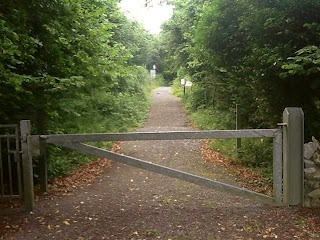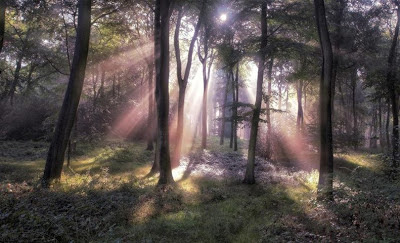Looking at The Second National Forest Inventory
Ireland's Second National Forest Inventory was published last month.
As you can expect this free downloadable PDF format document starts off with a several pages of waffle about how it was put together before presenting an spectacular number of charts that cover all kinds of information broken down nationally and county by county.
Here are some of the stats that fascinated me.
10.5% of Ireland's land mass is forest
89.5% of the land is used for other purposes
Forest cover is therefore very low compared to most European countries.
From that 89.5% of other land
3.9% is Hedgerows
0.7% is 'Other Woodland
which I would be inclined to include as forestry as hedgerows and 'other woodland' indicated to me Native Woodland.
Does this raise the real Ireland Tree Cover to 15.1%?
53.4% is Grazing land, while only
5% is Cropland
It is said that with better management that the 5% cropland could feed everyone with veggies, fruit and gains. I will always question why we need so much grazing land though.
15.6% of the land is Bog and Wetlands
1.5%, taken from the Bog lands is cut for personal turn
1.0% is taken commercially for power plants
1.2% is Scrub land that could be forestry land instead.
2.1% is the area covered by loughs, rivers and waterways,
which I am sure has trebled over the past month.
I am surprised it is that low though.
2.8% of the land is what we live on
and I am surprised that is low.
1% of this is urban living land.
53.2% of the forestry is Public Forestry
34% are private owned but grant aided,
meaning mainly monoculture conifers
12.8% are private owned with no grant help
so these will be mainly broad leaved native hardwoods
Looking at this closer
68.6% of forestry in Ireland is planted with conifers,
mainly Sitka Spruce and Norway Spruce
17.5% are broadleaved hardwoods
13.9% are mixed forests
However, looking at just the non grant aided forests
13.5% conifer
74% broadleaved
12.5% mixed.
Looking at JUST grant aided forests
77% conifer
8% broadleaved
so the government is still strongly motivating conifer.
Of course the species in this inventory is predictable but also sad,
showing us how the campaign for native species must go on.
Here are some more stats ...
Sitka Spruce 52.3% of trees in all forests
Scots Pine, the native conifer, 1.3%
Birch 5.9% (that's getting better)
English Oak 1.6%
Irish Oak 1%
Yew 0.008%
Crab Apple 0.007% (that's got to come up !!!)
Hazel 1.7%
I believe Sitka Spruce has become habit.
It is a tree viewed on spreadsheets and never in its environments.
When I see campaigns to get more farmers and other landowners to grow forestry its all about
how much money needs to be invested,
how much the Irish government will grant
and what the financial returns will be after 10, 20, 30 and 40 years.
Even non land owners are coaxed to invest on behalf of landowners as this is a means to plant money that is not only tax free, it seems, but includes a bonus from several other taxpayers through the grants.
What is not sold are the quality of life improvements and environmental benefits.
If this was sold I am sure there would be more diverse plantations, especially if landowners were advised of the incredible potential small business opportunities from leisure activity that could bring substantial revenue well before the first thinnings are ready.
However, that is not as simple as plant a monoculture crop and wait for the money to come in, a simplicity that seems, to me, to lack any potential of pride.
Click here to read the entire The Second National Forest Inventory report
where the stats for individual counties may be of greater interest to you too.
I believe these stats emphasise our need in Ireland to regain our culture relationship with forests that has been diluted away by farming, fashion industries, consumer marketing, and even the church who have linked a lot of paganism and sin to the forests in the past.
Many people seem to believe that a forest is a place of danger and satanic forces rather than be called to its wonder, healing, protection and essentials for our living and being here.
I believe it is our own culture change that directs and guides government policy, if it is representative of who we are. Being present and active in forests for our leisure, entertainment, health and re-learning of bushcrafts is a culture change that would have an impact, a good impact.
I hope you will participate in and enjoy this year's Bards In The Woods season, and perhaps through doing so influence at future change in these statistics just published so that we have a more native more wholesome functioning forestry culture in Ireland.
As you can expect this free downloadable PDF format document starts off with a several pages of waffle about how it was put together before presenting an spectacular number of charts that cover all kinds of information broken down nationally and county by county.
Here are some of the stats that fascinated me.
10.5% of Ireland's land mass is forest
89.5% of the land is used for other purposes
Forest cover is therefore very low compared to most European countries.
From that 89.5% of other land
3.9% is Hedgerows
0.7% is 'Other Woodland
which I would be inclined to include as forestry as hedgerows and 'other woodland' indicated to me Native Woodland.
Does this raise the real Ireland Tree Cover to 15.1%?
53.4% is Grazing land, while only
5% is Cropland
It is said that with better management that the 5% cropland could feed everyone with veggies, fruit and gains. I will always question why we need so much grazing land though.
15.6% of the land is Bog and Wetlands
1.5%, taken from the Bog lands is cut for personal turn
1.0% is taken commercially for power plants
1.2% is Scrub land that could be forestry land instead.
2.1% is the area covered by loughs, rivers and waterways,
which I am sure has trebled over the past month.
I am surprised it is that low though.
2.8% of the land is what we live on
and I am surprised that is low.
1% of this is urban living land.
53.2% of the forestry is Public Forestry
34% are private owned but grant aided,
meaning mainly monoculture conifers
12.8% are private owned with no grant help
so these will be mainly broad leaved native hardwoods
Looking at this closer
68.6% of forestry in Ireland is planted with conifers,
mainly Sitka Spruce and Norway Spruce
17.5% are broadleaved hardwoods
13.9% are mixed forests
However, looking at just the non grant aided forests
13.5% conifer
74% broadleaved
12.5% mixed.
Looking at JUST grant aided forests
77% conifer
8% broadleaved
so the government is still strongly motivating conifer.
Of course the species in this inventory is predictable but also sad,
showing us how the campaign for native species must go on.
Here are some more stats ...
Sitka Spruce 52.3% of trees in all forests
Scots Pine, the native conifer, 1.3%
Birch 5.9% (that's getting better)
English Oak 1.6%
Irish Oak 1%
Yew 0.008%
Crab Apple 0.007% (that's got to come up !!!)
Hazel 1.7%
I believe Sitka Spruce has become habit.
It is a tree viewed on spreadsheets and never in its environments.
When I see campaigns to get more farmers and other landowners to grow forestry its all about
how much money needs to be invested,
how much the Irish government will grant
and what the financial returns will be after 10, 20, 30 and 40 years.
Even non land owners are coaxed to invest on behalf of landowners as this is a means to plant money that is not only tax free, it seems, but includes a bonus from several other taxpayers through the grants.
What is not sold are the quality of life improvements and environmental benefits.
If this was sold I am sure there would be more diverse plantations, especially if landowners were advised of the incredible potential small business opportunities from leisure activity that could bring substantial revenue well before the first thinnings are ready.
However, that is not as simple as plant a monoculture crop and wait for the money to come in, a simplicity that seems, to me, to lack any potential of pride.
Click here to read the entire The Second National Forest Inventory report
where the stats for individual counties may be of greater interest to you too.
I believe these stats emphasise our need in Ireland to regain our culture relationship with forests that has been diluted away by farming, fashion industries, consumer marketing, and even the church who have linked a lot of paganism and sin to the forests in the past.
Many people seem to believe that a forest is a place of danger and satanic forces rather than be called to its wonder, healing, protection and essentials for our living and being here.
I believe it is our own culture change that directs and guides government policy, if it is representative of who we are. Being present and active in forests for our leisure, entertainment, health and re-learning of bushcrafts is a culture change that would have an impact, a good impact.
I hope you will participate in and enjoy this year's Bards In The Woods season, and perhaps through doing so influence at future change in these statistics just published so that we have a more native more wholesome functioning forestry culture in Ireland.





Government could alter bias towards quick growing 'lumber' but need good reason usually and cash is king.It stands with landowners making a (possibly) selfless choice to forego the option of a full 'harvest' in their lifetime and going for a long term native forest which could lead to a renewable cycle of forest maintenance, several kilowatts of Eco-joy per hectare (subject to confirmation), some profit (with work) for kids and grandchildren with only a slight risk of satanic churches springing up.......
ReplyDelete